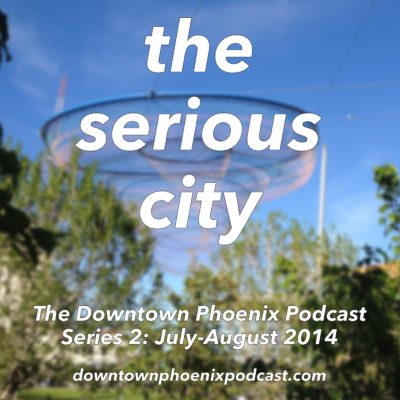[author’s note: When I wrote this essay, it turned out to be quite a long piece. In the interests of shortening it, it will be posted in two parts: the introductory part you are reading right now and the payoff post, as it were, will be published next week.]
 This week has been a perfect convergence of several events, conversations, and discoveries from the urban academy. (I love it when convergences like these happen!)
This week has been a perfect convergence of several events, conversations, and discoveries from the urban academy. (I love it when convergences like these happen!)
On the events front, you have probably listened to the final episode of my media project, The Downtown Phoenix Podcast. After a full eight-episode series with new content, it became readily apparent that if I wanted to accomplish what I had set out to do, a radio program (which the Podcast essentially is) wasn’t the best vehicle. That said, it was a blast to produce and I certainly learned a whole lot about both the medium of a podcast and the community in which we live. Still, though, it’s time to move on and stay on the cutting edge when it comes to sharing information about urban advocacy and thinking creatively about our cities. (If you’re reading this news for the first time, you should read this announcement.)
This week has been full of conversations, too: I had a phone chat with a friend who is spending some time away this brutal Phoenix summer in the Pacific Northwest and we discussed a lot of things, including the continued delays of the GRID Bicycle Share network’s launch. We discussed that some of the cities in the Pacific Northwest that have a strong bicycle culture and are known across the country and around the world for it (e.g., Portland, Ore.) do not have a bicycle share program but that has neither hindered nor hampered growth of bicycling there. We also wondered if Phoenix’s bicycle share system would be successful based on these criteria and what would happen during the summer, when outdoor activity should be curtailed.
And then there was the ongoing saga about the 1938 WPA-built Civic Building at the Arizona State Fairgrounds. The Arizona State Fair Board shelved plans to demolish the building, said to be in a sorry condition, after various preservation-minded people said the building should be preserved. Observant individuals will note that I was very quiet on this topic. My views on the historic preservation movement — especially in Phoenix — are in a state of flux. While I believe that we need to preserve our built environment, I think we need to be mindful of how we preserve things, working toward new and creative uses to incorporate these historic buildings and solely not just preserving their historic form and function. It’s nice and certainly a feel-good moment to save buildings but is it fundamentally okay to dictate to individuals and groups what to do with their buildings in the absence of proposals? As I commented in my 14 March 2014 edition of The Friday Urban Dispatches, we might need to rethink our decision-making philosophy: “Rather than saying ‘no’ outright, let’s ask this question: ‘No…but what are our alternatives?’” So, in this case, here’s the beginning of a conversation: “No, you shouldn’t demolish the Civic Building but here are some ideas — and funding sources — to rehabilitate the building to make the building useful for another 50-60 years.”
All of these conversations and events converged at a moment when I am asking of both myself and of our community: “What’s next?” My academic training is in urban studies and urban policy, after all, so I know my approach is different. I bring a different perspective to the table, something that I definitely understand. It’s frustrating to me when we consider some projects that have no academic basis for their success and, in my considered opinion, unfortunately won’t work. When we consider design above policy or economic activity, something I’ve strongly argued for in previous essays on this blog, that’s something that we should not be sustaining.
Enter in THE SERIOUS CITY. I’ll be talking about it more in depth on Monday’s essay, as promised, but I’ll quickly explain it here. A Serious City is a city that asks “why” in its decision-making processes. It understands true urban context and understands that sometimes, the best approach isn’t the one that’s being done in every other city. That’s not to say that benchmarking and taking smart practices from other cities is verboten; instead, it takes those practices and evaluates them in a manner consistent with its urban environment. It also understands how to respond and react to criticism levied against it, differentiating factual observations from hyperbole and stretching of the truth.
Whew. Next week’s essay — part II, if you will — will explain this in greater detail. Have a great weekend.
One thought on “Why 1 (a Primer for The Serious City)”
Comments are closed.